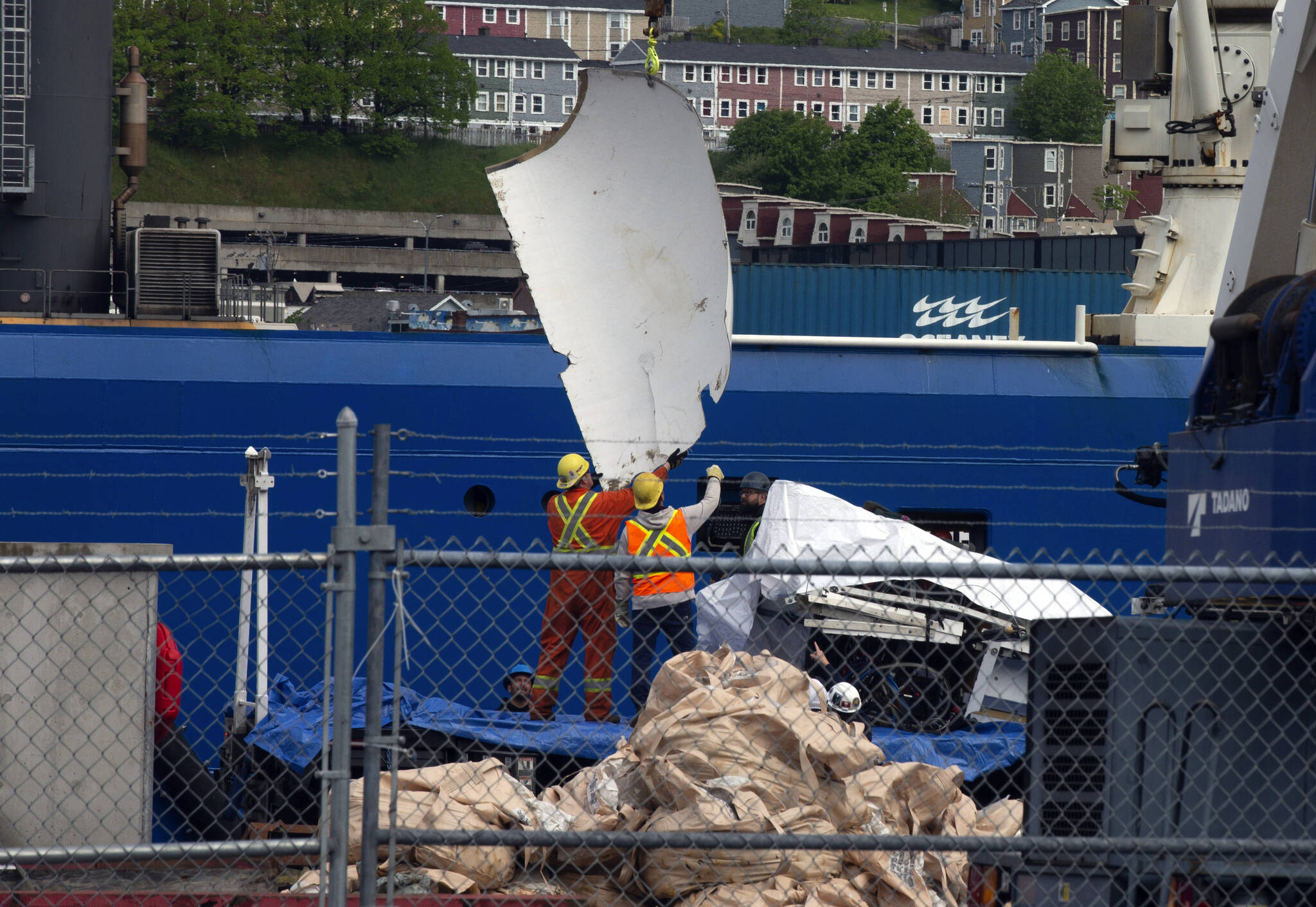The U.S. Coast Guard says it has likely recovered human remains from the wreckage of the Titan submersible and is bringing the evidence back to the United States. The submersible imploded last week, killing all five people on board. The vessel was on a voyage see the wreck of the Titanic.
The return of the Titan debris to port in St. John’s, Newfoundland and Labrador on Wednesday is a key piece of the investigation into why the submersible imploded. Twisted chunks of the 22-foot submersible were unloaded at a Canadian Coast Guard pier.
The U.S. Coast Guard said late Wednesday it had recovered debris and evidence from the sea floor and that included what it described as presumed human remains.
“I am grateful for the coordinated international and interagency support to recover and preserve this vital evidence at extreme offshore distances and depths,” U.S. Coast Guard Chief Capt. Jason Neubauer said in a statement. “The evidence will provide investigators from several international jurisdictions with critical insights into the cause of this tragedy. There is still a substantial amount of work to be done to understand the factors that led to the catastrophic loss of the TITAN and help ensure a similar tragedy does not occur again.”
The Canadian ship Horizon Arctic carried a remotely operated vehicle, or ROV, to search the ocean floor near the Titanic wreck for pieces of the submersible. Pelagic Research Services, a company with offices in Massachusetts and New York that owns the ROV, said on Wednesday that it has completed offshore operations.
Pelagic Research Services’ team is “still on mission” and cannot comment on the ongoing Titan investigation, which involves several government agencies in the U.S. and Canada, said Jeff Mahoney, a spokesperson for the company.
“They have been working around the clock now for ten days, through the physical and mental challenges of this operation, and are anxious to finish the mission and return to their loved ones,” Mahoney said.
Debris from the Titan was located about 12,500 feet (3,810 meters) underwater and roughly 1,600 feet (488 meters) from the Titanic on the ocean floor, the Coast Guard said last week. The Coast Guard is leading the investigation into why the submersible imploded during its June 18 descent. Officials announced on June 22 that the submersible had imploded and all five people on board were dead.
The Coast Guard has convened a Marine Board of Investigation into the implosion. That is the highest level of investigation conducted by the Coast Guard.
One of the experts the Coast Guard consulted with during the search said analyzing the physical material of recovered debris could reveal important clues about what happened to the Titan. And there could be electronic data, said Carl Hartsfield of the Woods Hole Oceanographic Institution.
“Certainly all the instruments on any deep sea vehicle, they record data. They pass up data. So the question is, is there any data available? And I really don’t know the answer to that question,” he said Monday.
Representatives for Horizon Arctic did not respond to requests for comment.
Ocean Gate CEO and pilot Stockton Rush was k illed in the implosion along with two members of a prominent Pakistani family, Shahzada Dawood and his son Suleman Dawood; British adventurer Hamish Harding; and Titanic expert Paul-Henri Nargeolet.
Representatives for the National Transportation Safety Board and Transportation Safety Board of Canada, which are both involved in the investigation, also declined to comment. The National Transportation Safety Board has said the Coast Guard has declared the loss of the Titan submersible to be a “major marine casualty” and the Coast Guard will lead the investigation.
“We are not able to provide any additional information at this time as the investigation is ongoing,” said Liam MacDonald, a spokesperson for the Transportation Safety Board of Canada.
A spokesperson for the International Maritime Organization, the U.N.’s maritime agency, has said any investigative reports from the disaster would be submitted for review. Member states of the IMO can also propose changes such as stronger regulations of submersibles.
Currently, the IMO has voluntary safety guidelines for tourist submersibles which include requirements they be inspected, have emergency response plans, and have a certified pilot on board among other requirements. Any safety proposals would not likely be considered by the IMO until its next Maritime Safety Committee which begins in May 2024.
OceanGate Expeditions, the company that owned and operated the Titan, is based in the U.S. but the submersible was registered in the Bahamas. The OceanGate company in Everett, Washington closed when the Titan was found. Meanwhile, the Titan’s mother ship, the Polar Prince, was from Canada.
The operator charged passengers $250,000 each to participate in the voyage. The implosion of the Titan has raised questions about the safety of private undersea exploration operations. The Coast Guard also wants to use the investigation to improve safety of submersibles.

